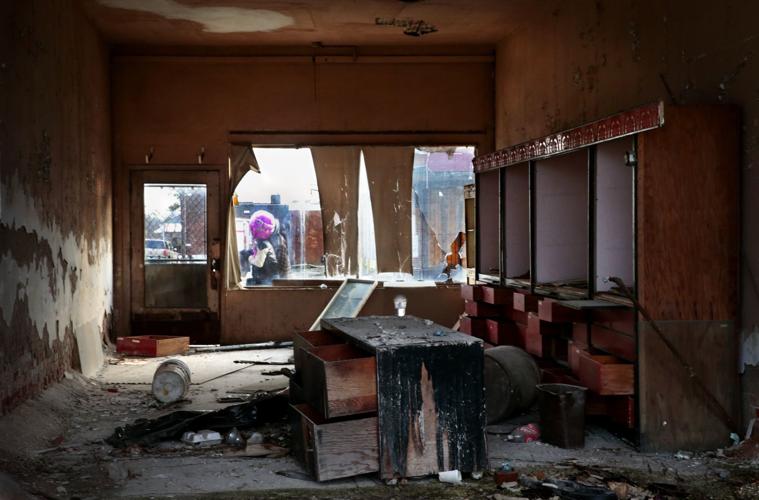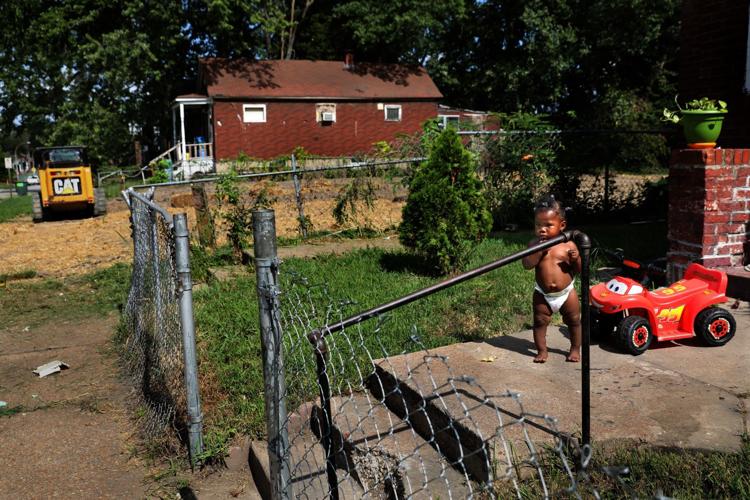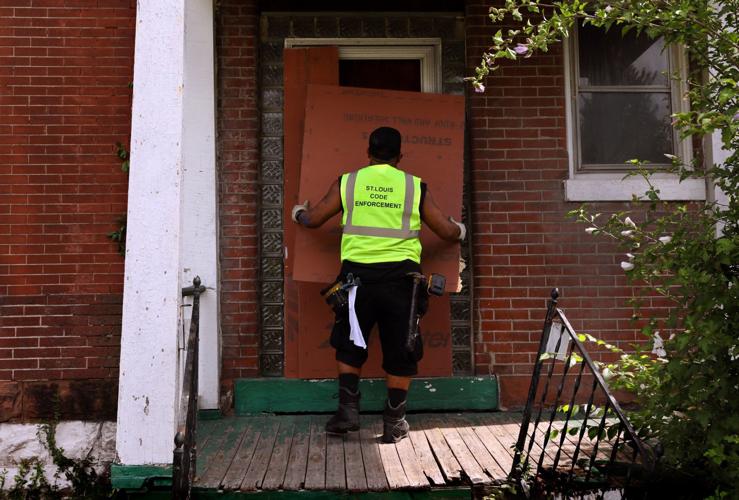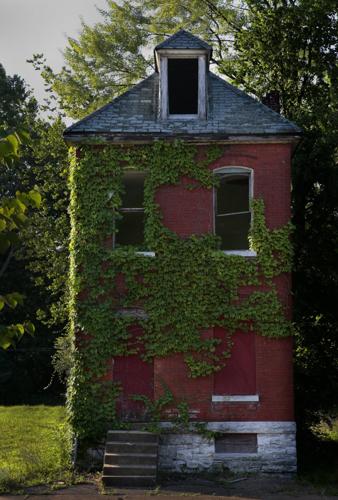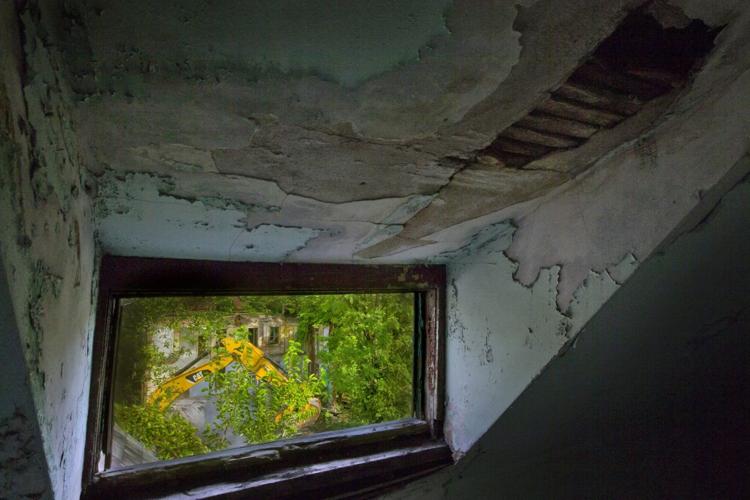ST. LOUIS┬Ā┬ĀŌĆó┬Ā┬ĀIn January, someone hid behind the empty house next to Jennifer WalterŌĆÖs home in the Walnut Park East neighborhood and shot her husband.
A case of mistaken identity, she believes. Her husband survived, but the shooter was never found.
ŌĆ£TheyŌĆÖre running from the police, running through these vacant houses,ŌĆØ Walter said, gesturing to the empty buildings that dot her street.
The dilapidated building where the shooter hid had been owned since 2012 by the Land Reutilization Authority, the cityŌĆÖs land bank.
As the owner of almost half of ├█č┐┤½├ĮŌĆÖ 25,000 vacant lots and buildings, LRA has long been in the crosshairs of city residents unhappy with the way the agency maintains its vast property holdings.
ThatŌĆÖs not news to Laura Costello, LRAŌĆÖs director of real estate. ŌĆ£I get beat up at every neighborhood meeting I go to,ŌĆØ she says.
People are also reading…
LRA became the cityŌĆÖs biggest owner of abandoned property because of forces unleashed in the 1960s, as people and businesses left for the suburbs ŌĆö and unpaid real-estate taxes piled up in the city. required the city to file suit against each individual parcel of tax-delinquent land in order to attempt to collect revenue ŌĆö an unfeasible task.
City Hall at the time decided ├█č┐┤½├Į needed a state law that would allow it to hold, maintain and eventually sell vacant property with a clear title for redevelopment, in hopes of revitalizing decaying neighborhoods. In 1971, the LRA ŌĆö the nationŌĆÖs first city-run land bank ŌĆö was born.

This two-story home at 2150 E College Avenue in the College Hill neighborhood is currently the longest-owned LRA property, acquired on Dec. 19, 1986. Built in 1884, it was recently photographed on Friday, July 13, 2018. Photo by Robert Cohen, rcohen@post-dispatch.com
Once LRA began taking properties that didnŌĆÖt sell at ├█č┐┤½├Į sheriffŌĆÖs office tax sales, its inventory quickly swelled, and it ended up with thousands of broken buildings and empty lots. In 1991, just 20 years after LRA was created, then-Building Commissioner Martin Walsh told the Post-Dispatch that ŌĆ£.ŌĆØ
ThatŌĆÖs still true, 27 years later.
The LRA sells somewhere between 500 and 550 properties a year, but it canŌĆÖt seem to make a significant dent in the amount of land under its control.
Some on the Board of Aldermen have called on the land bank to be more aggressive in reducing its inventory.
The small staff tasked with managing and marketing about 12,000 parcels say theyŌĆÖre open to new ideas to get more of those properties back on the tax rolls or into the hands of nonprofit groups that can maintain them.
But thatŌĆÖs hard to do without resources. LRA is funded primarily through its own sales and federal pass-through grants, not the cityŌĆÖs general revenue fund. It operates at a near constant deficit, writing IOUs to the cityŌĆÖs economic-development arm, the ├█č┐┤½├Į Development Corp., for the difference.
ŌĆ£We donŌĆÖt make enough money every year to take care of these properties,ŌĆØ Costello said. ŌĆ£We could use a lot more help. We could use a lot more demolition money and more maintenance people.ŌĆØ
ŌĆśWe are comingŌĆÖ
The slow pace of demolition has been a major reason why the number of vacant buildings in the city has risen dramatically. ItŌĆÖs up 40 percent since 2009, topping 7,000 buildings, including about 4,000 that have been condemned as unsafe. While LRA once spent roughly $3 million a year on demolitions, the money has been systematically cut over time.
ŌĆ£Being mad at LRA is like being mad at someone because theyŌĆÖre poor,ŌĆØ Mayor Lyda Krewson told the Post-Dispatch this summer.
At least in the short term, thatŌĆÖs improving. With vacancy a top priority for Krewson, she pushed for roughly $3.6 million in the fiscal 2019 budget to tear down some of the cityŌĆÖs most dangerous properties, and she says sheŌĆÖs committed to pushing for at least as much every year sheŌĆÖs in office.

Looking out a window at 1701 Marcus Avenue in the Kingsway East neighborhood, an excavator demolishes 4715 Cote Brilliante Avenue on Saturday, July 28, 2018. Shortly after, the Marcus house built in 1889 was also taken down as part of a Clean Sweep event, a summer initiative of Better Family Life where contractors volunteer to tear down vacant houses and neighborhood volunteers clean the areas. Photo by Robert Cohen, rcohen@post-dispatch.com
As a north ├█č┐┤½├Į neighborhood meeting last month veered into complaints about vacant property, CostelloŌĆÖs boss, SLDC Director Otis Williams, touted the new demolition money and a commitment from the Metropolitan ├█č┐┤½├Į Sewer District to supplement it with another $2 million to create stormwater-absorbing green space. The pace of demolition will pick up, he told the residents.
ŌĆ£While we may not get there next week, we are coming,ŌĆØ he said.
An elderly woman sat on her Davison Street porch this month, watching as a backhoe ripped into the LRA-owned house next door. Some of that MSD money had reached Walnut Park East.
People ŌĆö drug users, she said ŌĆö came in and out of the house, and she wanted it gone. ŌĆ£IŌĆÖve been asking for five years,ŌĆØ she said, declining to give her name.
A block away, construction crews were scattering straw on the newly created empty lot next to WalterŌĆÖs house, the one that once held the building where her husbandŌĆÖs shooter took cover.
ŌĆ£We need to get rid of some more of these things,ŌĆØ she said.
ŌĆśNo one wants itŌĆÖ
The best way to keep properties from getting to the point that they pose a danger to neighbors may be to keep them out of the hands of the LRA.
A new push to reach out to residents and neighborhood organizations may be paying off at the tax sales that offer a last chance for someone to buy a property before it heads to the LRA. The agency is sending representatives to more meetings, educating the public on how to acquire vacant property. ItŌĆÖs only taken in 187 properties this year after three of five annual tax sales.
Given that the land bank typically rakes in 500-600 unwanted properties every year, this yearŌĆÖs lower total shows the public is becoming aware that they can buy these properties at those sales, Costello said. That means fewer parcels make it into the cityŌĆÖs inventory.

Albert Toliver spends his 16th birthday stacking brick in an industrial lot off Goodfellow Boulevard and Natural Bridge Avenue on Wednesday, July 11, 2018. Through a job-creating initiative of Fred Weber Inc. and Better Family Life, workers recover brick from homes demolished during summer Clean Sweep events, selling them for reuse. As homes were taken down, materials were hauled to this lot where brick cleaners sorted through construction debris, picking and cleaning the bricks. They were paid $50 per pallet of 520 bricks. Photo by Robert Cohen, rcohen@post-dispatch.com
Selling parcels the city already owns ŌĆö some of which have sat dormant for decades ŌĆö is trickier. The reality is that no one has expressed interest in more than 40 percent of the city-owned lots or buildings, Costello said.
ŌĆ£Not a phone call, not an offer, anything. No one wants it,ŌĆØ she said.
That hasnŌĆÖt stopped aldermen, though, nor candidates for citywide office from pushing the LRA to more aggressively reduce its holdings.
The Board of Aldermen this month passed a resolution directing the ├█č┐┤½├Į Development Corp. to develop a $1 home purchase program, an idea loosely modeled on a similar initiative in Kansas City.
Sponsoring Alderman John Collins-Muhammad estimates that 80 percent of his job is responding to constituents on issues that stem from vacant buildings or lots in the 21st Ward: tall grass, illegal dumping and people illegally moving into abandoned property.
Selling homes for $1 would encourage more people to move to north ├█č┐┤½├Į, and the city would save money with fewer properties to maintain, he argues.
The idea of selling vacant homes for $1 isnŌĆÖt new. In 1976, then-28th Ward Alderman Vincent C. Schoemehl Jr., who would go on to be mayor of ├█č┐┤½├Į, introduced his own resolution to do just that.

A portrait of Tina Turner created by artist Chris Green covers boarded property along Page Boulevard in Fountain Park on Tuesday, July 18, 2018. Better Family Life commissioned the artwork to beautify the Fountain Park neighborhood. Photo by Robert Cohen, rcohen@post-dispatch.com
The roadblock then and now is that the LRA is governed by state statute, and a provision in that law states the land bank cannot sell its properties at less than two-thirds of the estimated value without written permission from two of the three offices that appoint LRA board members: the mayor, the comptroller and the School Board. Sometimes, the land bank will sell for less if a property has been in the inventory for a very long time, but itŌĆÖs difficult to get signatures from the appointing authorities, Costello said.
Some aldermen also fear such a program would yield more residents buying up homes at a rock-bottom rate but finding themselves ill-equipped for the renovations, or unable to secure financing at the bank.
ŌĆ£A lot of times those properties have sat for so long, and what itŌĆÖs going to cost to fix, theyŌĆÖll have to go to a lender to get it repaired,ŌĆØ said 27th Ward Alderman Pam Boyd. If people snatch up $1 homes but later canŌĆÖt get a loan, the city will just have to take over the property again, she said.
For an agency reliant on sales income, $1 buildings wonŌĆÖt pay the bills. It can cost hundreds of dollars just to get a property into LRAŌĆÖs inventory, before factoring in annual maintenance and insurance. In the alternative, demolishing a building costs the agency about $12,000. Without any return on that investment, Costello said, the LRA may be rendered unable to operate or perform basic maintenance on its inventory, such as grass cutting and boarding up empty homes.
Adding staff
In 2017, LRA sold 551 parcels for a total of $1.2 million. Not every offer was accepted. Some offers are rejected because the LRA is holding onto property for future development, but more often, Costello says, itŌĆÖs because a prospective buyer has problems with other properties, or because they have almost no money.
Those interested in acquiring LRA property are expected to show they have some seed money to get started. No one is expected to have the full amount needed to fix up the property in order to buy it. If they imposed that requirement, ŌĆ£we would never sell one property,ŌĆØ Costello said.
If owners havenŌĆÖt paid taxes for three years, and if a property isnŌĆÖt sold at public tax sales, the LRA takes control.
Land banks in other cities can pick and choose which properties they take into their inventory, and may only select ones they know they can rehab or sell. The municipalities themselves are responsible for the properties no one wants.
But LRA was formed to relieve ├█č┐┤½├Į of that burden, Costello said. They donŌĆÖt have the option to be selective. They take what no one else wants. The best property is bought by investors at the tax foreclosure sale. The LRA takes the rest.
That makes the LRAŌĆÖs job of returning abandoned land to productive ownership all the more challenging. Yet it is underresourced compared to similar agencies.
In 2017, the Environmental Protection Agency commissioned , which found an extremely large land-banked inventory for a city of roughly 300,000 people. While LRA has about 12,000 properties, Pittsburgh and New Orleans, two cities of comparable size, have about 7,000 and 2,000 publicly owned vacant properties, respectively. And with just 10 administrative staffers to handle all those properties, LRA had fewer people and a smaller budget than comparable land banks.
The study recommended doubling the number of LRA employees, performing a comprehensive analysis of its inventory and adopting a better system for categorizing properties.
The city should also lobby the state for reforms to reduce waiting periods before tax-delinquent vacant properties can be taken and sold by streamlining the process, according to the report. It also needs to clarify how it takes title to property, because concerns over clear title and proper notice to former owners can make title insurers, and thus lenders, hesitant to deal with LRA properties.

A city code enforcement worker boards up a privately-owned vacant house in the 4800 block of Cote Brilliante Avenue on Saturday, July 28, 2018, during a Clean Sweep neighborhood cleanup and house demolition event. Photo by Robert Cohen, rcohen@post-dispatch.com
As for adding staff, LRA has made two administrative hires. Costello isnŌĆÖt sure more are needed ŌĆö her staff is able to process the roughly 75 offers that come in a month. More staff to market properties could help boost demand, she said. But what would be more helpful is 10 more maintenance workers to help with the upkeep of publicly-owned property, she said.
ŌĆ£I think thereŌĆÖs a hundred things that lead to the property being foreclosed on. I donŌĆÖt think LRA is the problem, itŌĆÖs the solution,ŌĆØ Costello said. ŌĆ£I really think unless thereŌĆÖs a lot of fixes everywhere, thereŌĆÖs not going to be a fix for the LRA inventory. WeŌĆÖre not ever going to be at zero.ŌĆØ
Janelle OŌĆÖDea of the Post-Dispatch contributed to this report.
This story is part of the ŌĆ£Tipping PointŌĆØ series of special reports that examine critical challenges facing ├█č┐┤½├Į neighborhoods.
Previously:
Next Sunday: Nonprofits, businesses pitch in.




































